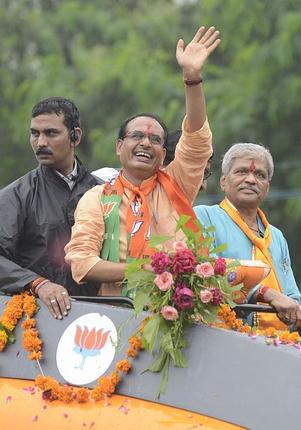 July 25;The giant billboards that greeted people on the streets earlier this week when Madhya Pradesh Chief Minister Shivraj Singh Chouhan launched his 50-day Jan Ashirwad Yatra ahead of assembly elections slated for the end of the year, featured almost the entire BJP pantheon. From its revered leaders Atal Behari Vajpayee and L.K. Advani to party chief Rajnath Singh and Leader of Opposition Sushma Swaraj, they were all there.
July 25;The giant billboards that greeted people on the streets earlier this week when Madhya Pradesh Chief Minister Shivraj Singh Chouhan launched his 50-day Jan Ashirwad Yatra ahead of assembly elections slated for the end of the year, featured almost the entire BJP pantheon. From its revered leaders Atal Behari Vajpayee and L.K. Advani to party chief Rajnath Singh and Leader of Opposition Sushma Swaraj, they were all there.
Only one face was conspicuous by its absence — that of the BJP’s posterboy and, currently, the party’s election campaign chief, Narendra Modi.
Asked by journalists why Mr Modi was missing from the images of the party’s great and good, the 54-year-old Mr Chouhan, seeking a third term in office, dismissed the question as provoking an “unnecessary controversy”. Pressed, he gave a measured response: “He is like my elder brother. His blessings are always with me.”
But Madhya Pradesh’s low profile chief minister, a favourite of Mr Advani, probably knew what he was doing: the CNN IBN-The Hindu Election Tracker poll conducted by the Centre for the Study of Developing Societies (CSDS) shows that in his home state 49 per cent of respondents would prefer to see Mr Chouhan emerging as the BJP’s prime ministerial candidate as compared with just 28 per cent for Mr Modi. Among the BJP faithful, the figure for Mr Chauhan is even higher – 51 per cent for him, 36 per cent for his counterpart from Gujarat. In 2009, the BJP won 16 of the 29 Lok Sabha seats from Madhya Pradesh, and 15 of the 26 in Gujarat.
The CSDS survey also suggest that if general elections were to be held now, the BJP’s 2009 vote share of 43 per cent would go up by seven percentage points, while that of the Congress would fall from 40 per cent to 32 per cent in the same period. The Bahujan Samaj Party stands at a steady six per cent. If there is a window of hope for the Congress, it is that 15 per cent of those polled were undecided.
But unlike the results of the poll conducted in Gujarat, the BJP’s possible increase in vote share is matched by the growing popularity of Mr Chauhan, chief minister since November 2005, when mid-term, he replaced Babulal Gaur. His administration’s approval rating has climbed from 50 per cent to 64 per cent since July 2011 (when the CSDS had done another survey). Madhya Pradesh also tops a table on satisfaction levels with the performance of 18 state governments, rising from an already high 68 per cent in July 2011 to a whopping 82 per cent now. Only in four other states has satisfaction with the government risen in the same period: the Biju Janata Dal-ruled Orissa, the Congress-headed Rajasthan and Maharashtra, and Jharkhand, where a JMM-Congress coalition recently took over.
If Mr Chouhan’s personal popularity has grown along with that of his government, in the absence of a Gujarat-style propaganda machine – and despite his self-effacing style — his model of development must be working.
Indeed, his close to eight years in power appear to have obliterated the record of the Congress’s Digvijaya Singh, who ruled Madhya Pradesh between 1993 and 2003. To a question on how his government compared with that of Mr Singh, 75 per cent rooted for him, only eight per cent for the Congress leader. Even among traditional Congress supporters, 56 per cent said Mr Chouhan had outperformed Mr Singh; the reverse was true among 21 per cent.
Simultaneously, Mr Chouhan has created public opinion against the Centre: the state government is right in accusing the Centre of not giving enough funds to Madhya Pradesh, 30 per cent of the respondents said; conversely, 16 per cent believe that the Congress is right when it accuses the state government of taking credit for funds given by the Centre for centrally administered schemes.
Statistically, the BJP’s vote share over the last two elections, both to the Lok Sabha and the state assembly, has been steadily decreasing: in 2004, the BJP got 48.13 per cent that converted to 25 Lok Sabha seats; in 2009, it fell to 43 per cent and 16 seats. In the assembly elections in 2003, the BJP got 42.5 per cent of the vote share and 173 seats; in 2008, it got 37.64 per cent and 143 seats. Correspondingly, the Congress’s vote share has grown from 34.07 per cent in 2004 to 40 per cent in 2009, pushing its score from four to 12 in the Lok Sabha, and from 31-6 per cent in 2003 to 32.85 per cent in 2008, increasing its tally in the assembly elections from 38 to 71.
Can the Congress keep the pressure on? Or, as the CSDS poll predicts, it will continue to be advantage Mr Chouhan?
